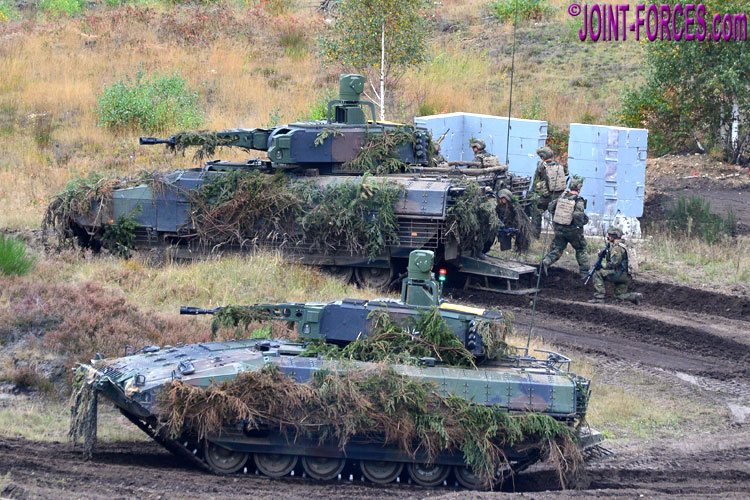
Between 7th and 11th October the German Armed Forces are showcasing their capabilities during a demonstration at the Munster and Bergen training areas, writes Carl Schulze.
~
The Army, Forces Support Command, Armed Forces Medical Service and Cyber Warfare Command of the German Armed Forces are all showcasing their capabilities during this demonstration exercise being held at Munster and Bergen.
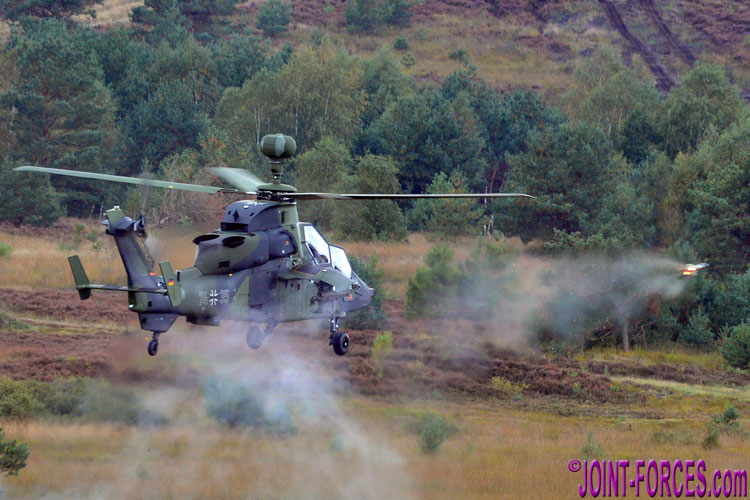
The capability demo involves some 2,000 troops and well over 100 tracked plus 450 wheeled vehicles, as well as transport and combat helicopters. Elements of the Royal Netherlands Army and the Austrian Army are also participating in the exercise, which Joint-Forces.com is following in order to provide readers with a short briefing on current developments.
Conducted annually, the Informationslehrübung Land Operationen (ILÜ LandOp) has the main aim of briefing those officer cadets and future leaders of the Bundeswehr studying at the Offizierschule des Heeres (OSH) and the future staff officers of the Bundeswehr studying at the Führungsakademie der Bundeswehr (FüAkBw) on the capabilities of the German ground forces and the way the different arms and branches cooperate during joint operations. The demonstration exercise features eight stands that complement each other and at which, over a period of two days, the audience is shown the capabilities in realistic settings.
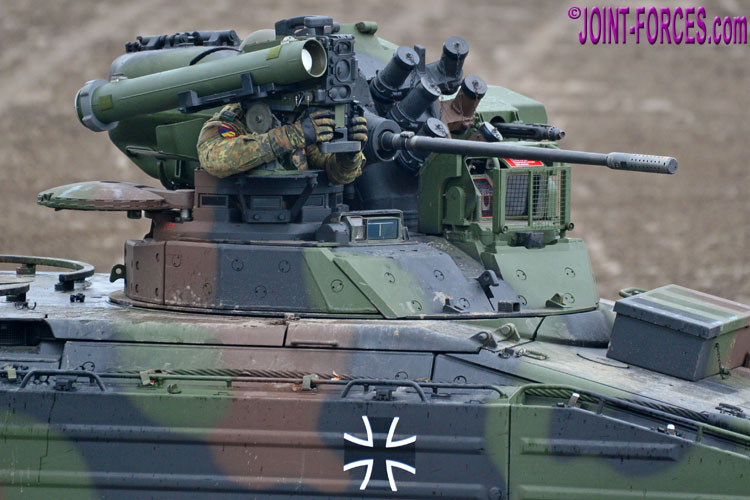
While in the past set within a Stabilisation Operation scenario, since 2016 the ILÜ LandOp has been based on a National and NATO collective defence scenario. This year’s exercise is jointly directed by Generalleutnant Jörg Vollmer, Chief of Staff of the German Army, Generalleutnant Martin Schelleis, Chief of Staff of the Forces Support Command, Generaloberstarzt Dr. Ulrich Baumgärtner, Chief of Staff of the Armed Forces Medical Service and Generalleutnant Ludwig Leinhos, Chief of Staff of the Cyber Warfare Command of the German Armed Forces. The Ausbildungszentrum Munster, the central training establishment of the German Army for its armoured, reconnaissance and indirect fire assets, is responsible for coordinating the exercise. Forces participating in ILÜ LandOp 2019 are provided by a large number of units of the mentioned commands of the Bundeswehr. The bulk of the troops of the German Army are provided by the Munster-based Panzerlehrbrigade 9 (9th Armoured Brigade).
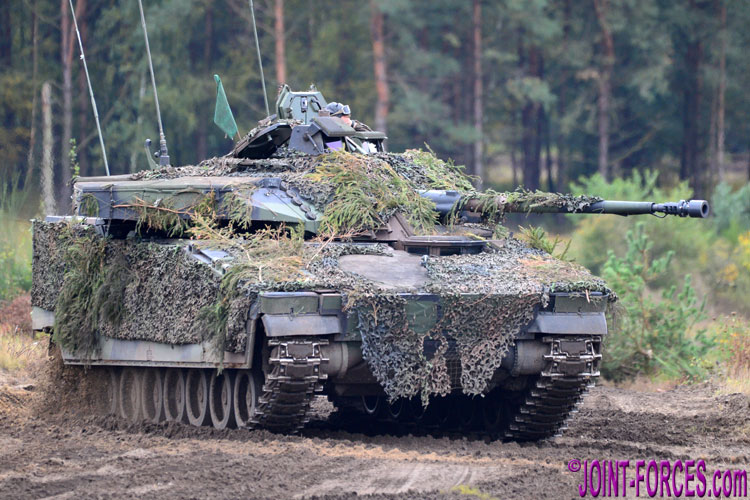
The eight stands of ILÜ Land OP 2019 are:-
- Stand 1: Landstreitkräfte im Einsatz – Dynamic display showcasing the capabilities of major weapon systems, wheeled and tracked vehicles, helicopters and other equipment in service with the Army, Forces Support Command, Armed Forces Medical Service and Cyber Warfare Command of the German Armed Forces.
- Stand 2: Logistische Fähigkeiten im Rahmen von Reception, Staging and Onward Movement (RSOM) – Demonstration of the Forces Support Command showcasing its logistic capabilities provided to land forces while being deploying from their home bases to a staging area in an allied country in close proximity to an area of operations. This stand is set within the logistic core of a staging area for up to four combat forces battalions. All facets of the RSOM process are shown, ranging from the arrival of troops and their heavy equipment, the merging of the two, the supply of fuel, ammunition, food and water, to the providing of maintenance and repair support and so on.
- Stand 3: Stationskreislauf statische Fähigkeitendarstellung Streitkräftebasis (SKB), Zentraler Sanitätsdienst der Bundeswehr (ZSanDst Bw) und Kommando Cyber– und Informationsraum (CIR) – This stand was divided in three parts and provided the audience with an overview of the tasks and equipment fielded by the units of the Forces Support Command, Armed Forces Medical Service and Cyber Warfare Command of the German Armed Forces. On show are vehicles, command, control, communication and intelligence (C3I) equipment, logistic vehicles and engineer equipment. The stand also includes a small dynamic demonstration of a Close Protection Team from the Feldjäger military police. The medical service part of the stand includes complete Role 1 and Role 2 medical facilities, as well as a range of armoured and soft skinned ambulance vehicles.
- Stand 4: Rettungszentrum – Dynamic demonstrations of the capabilities of a Role 2 medical facility of the Armed Forces Medical Service. The Rettungszentrum consists of 77 ISO-20-foot-container and 40 Einheitszelte Typ II tents. It mainly features an emergency room, an X-ray facility, the clinical-chemical-laboratory, the the sterilisation area, a pharmacy with a medical supply storage facility, a dental care facility and a operating/surgery theatre.
- Stand 5: Versorgung eines Kampftruppenbataillons – The stand focuses on Level 1 logistic support, providing the spectators with information about the capabilities of the logistic assets of a battalion-size combat unit and the way they are employed.
- Stand 6: Bataillonsgefechtsstand – At this stand an exemplary battalion command post of a combat unit is showcased. Its different elements are explained and the way of decision and order making explained. The stand also involves a demonstration of the tactical mobile command post of a battalion commander.
- Stand 7: Rettungsstation – This stand showcases a Role 1 medical facility employed in support of an all arms battle group and provides information on its structure, personnel and capabilities, as well as the general structure of the medical support system.
- Stand 8: Gefechtsschießen Operation verbundener Kräfte – The grand finale of the ILÜ Land OP 2019 stands comes in form of a joint combined all arms fire power demonstration. The demonstration is held on Range 1A of the Bergen training Area and broken down in two major parts. Part one sees a reinforced battle group centred around the Austrian Panzerbataillon 14 tank battalion, fighting a delaying battle against advancing superior enemy forces. Part two then sees the reinforced German Panzergrenadierbataillon 33 armoured infantry battalion conducting a counter attack. As part of the attack a water obstacle has to be crossed by the means of a armoured bridgelayer, an urban area is cleared by armoured infantry and light infantry assets, reconnaissance assets deployed in front of the main attack, rocket and barrel artillery fired, Leopard 2A6 main battle tanks and Schützenpanzer Puma armoured infantry fighting vehicles break through the enemy lines and combat aircraft of the Luftwaffe provide close air support. The counter attack also involves elements of the 45 Pantserinfanteriebataljon Oranje Gelderland of the Koninklijke Landmacht of the Netherlands.
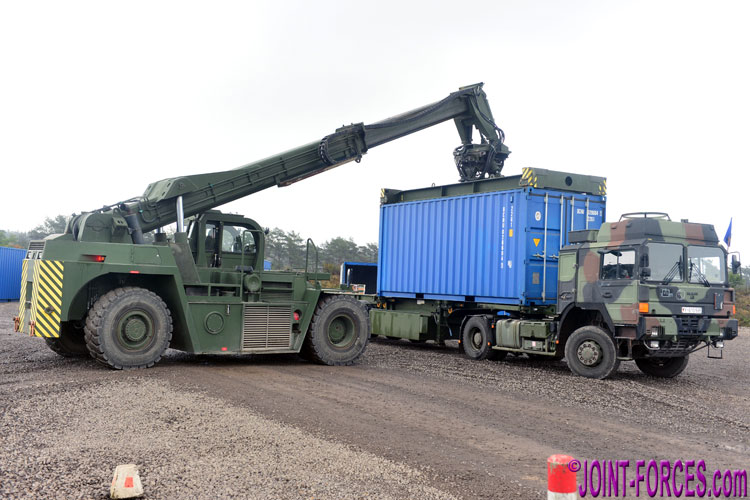
Conclusion: Like previous ILÜ events, this year’s ILÜ Land OP 2019 is without doubt an impressive demonstration of the capabilities of the ground forces of the Bundeswehr. Since the 1990s the German land forces were mainly focused on conducting counter-insurgency and stabilisation operations. It was only recently that this focus changed back to National and NATO collective defence. During ILÜ Land OP 2019 the ground forces of the Bundeswehr prove their capabilities in this field of military operations.
[images © Carl Schulze]
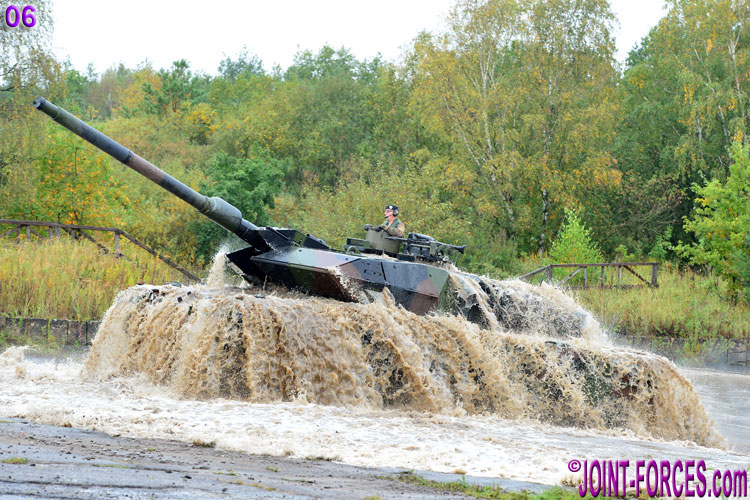
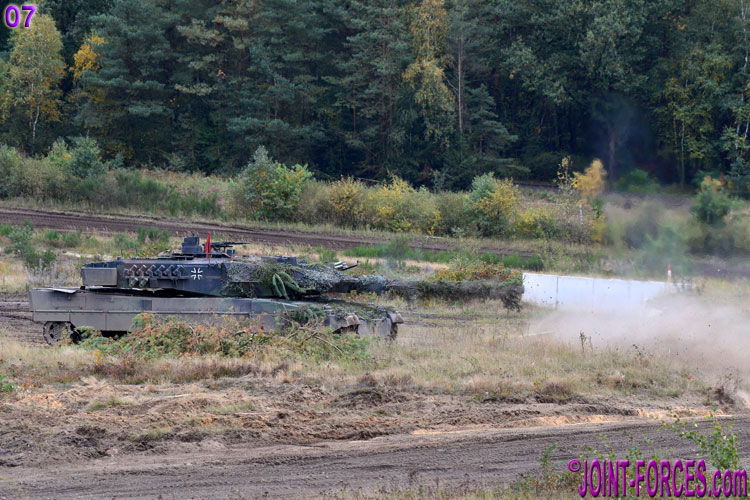
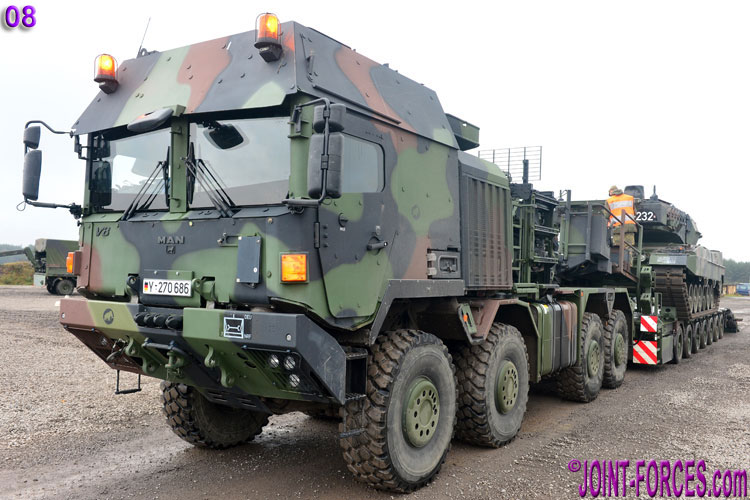
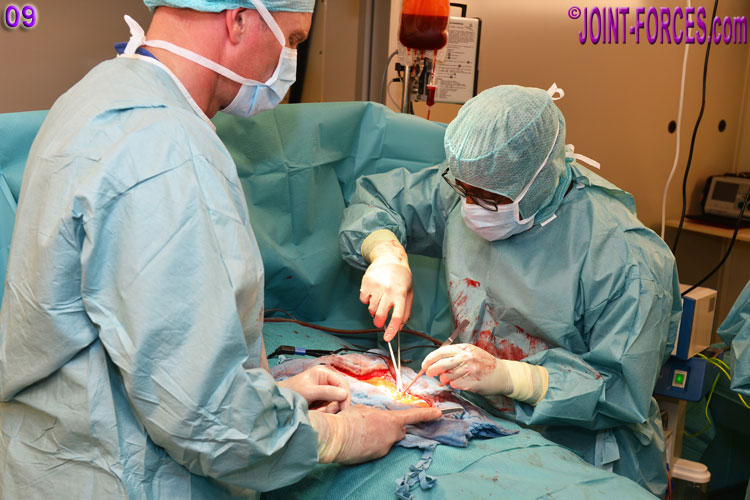
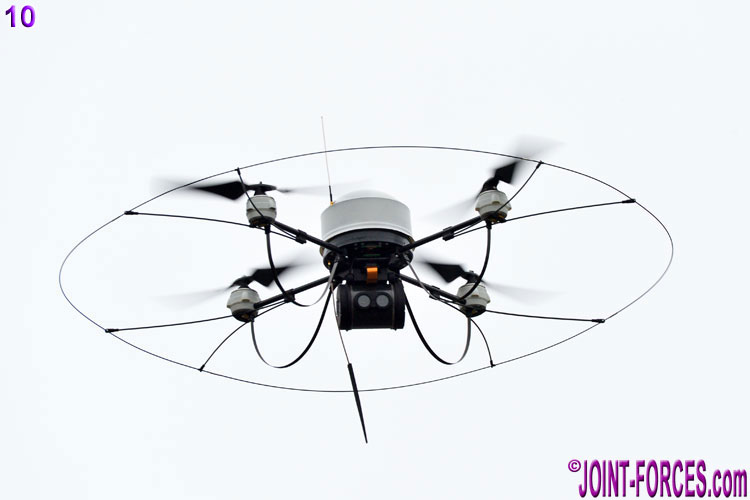
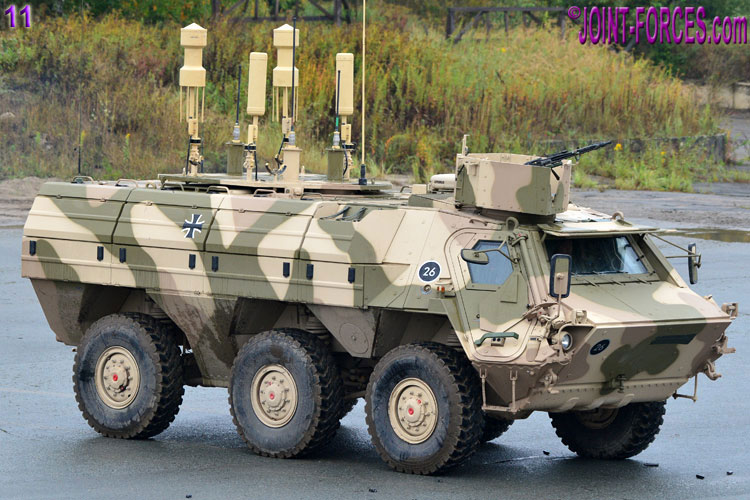
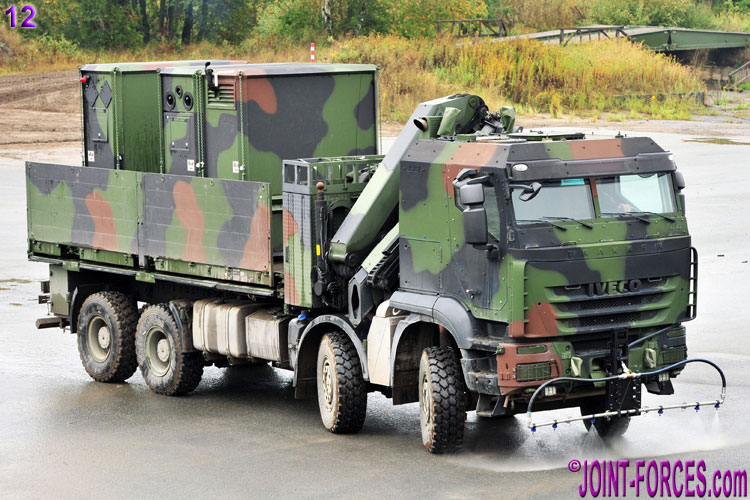
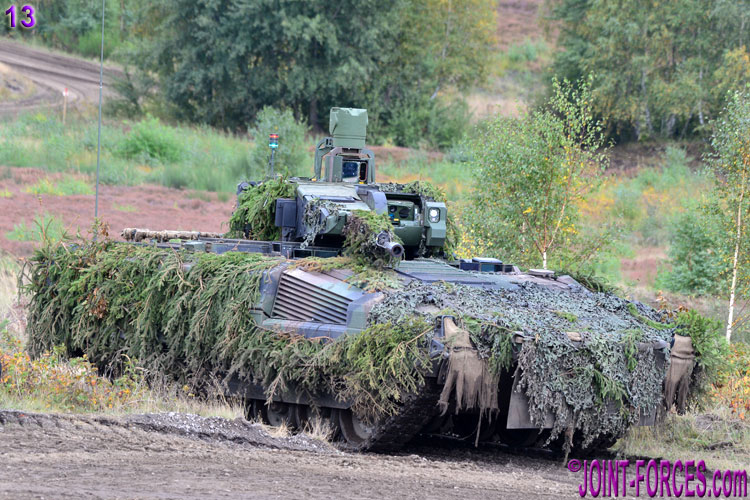
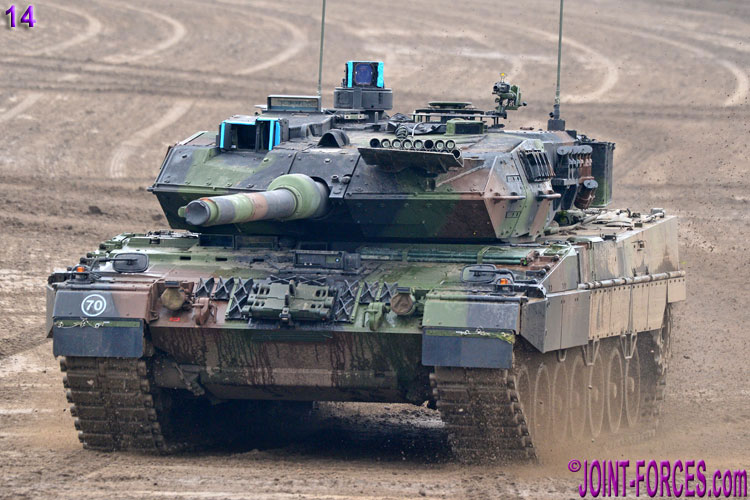
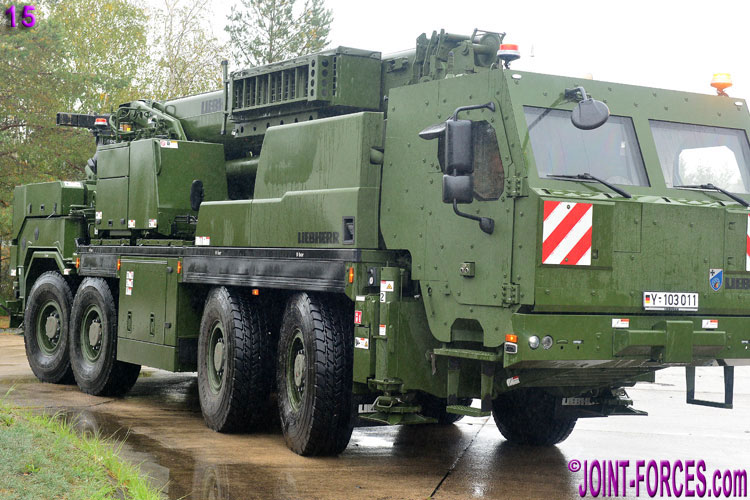
Image key:-
- 06 – Stand 1: A Leopard 2A6 main battle tank negotiates a water obstacle. With deep fording kit installed the MBT can pass through 2.25m deep water. When fitted with the underwater driving tower 4m deep water can be forded
- 07 – Stand 8: During the counter-attack a Leopard 2A6 engages enemy armour with its 120mm L/55 smoothbore tank gun
- 08 – Stand 2: A Leopard 2A6 MBT is arriving on a Schwerlasttransporters SLT 2 70 t Mammut heavy equipment transporter at the logistic core of the staging area, after being picked up at the port of debarkation
- 09 – Stand 4: Surgery is conducted in the Rettungszentrum Role 2 medical facility of the Armed Forces Medical Service. The facility consists of containers and tents
- 10 – Stand 1: The Mikroaufklärungsdrohne für den Ortsbereich (MIKADO) is one of the UAVs employed by the German Army’s reconnaissance assets. It can be fitted with a daylight or an infrared night vision camera, has a range of 1,000m and an endurance of 20 minutes
- 11 – Stand 1: The Transportpanzer 1 Fuchs wheeled armoured personnel carrier is fielded in many variants by the German land forces. Here a Transportpanzer 1A8 Fuchs fitted with the Störausstattung Counter Explosive Device Gerät CG-20+ jammer can be seen. The vehicle is employed to protect static locations, convoys and patrols from attacks with Radio Controlled Improvised Explosive Devices
- 12 – Stand 1: Based on an Iveco Trakker 8×8 truck the Material Entgiftungs-, Entseuchungs-, Entstrahlungs und Entwesungsplatz (MEP) can be employed to decontaminate vehicles, large equipment and infrastructure etc. after they have been exposed to CBRN threats
- 13 – Stand 8: The armament of the Schützenpanzer Puma armoured infantry fighting vehicle consists of a 30mm MK 30-2/ABM automatic cannon and a coaxial 5.56 mm MG4 machine gun
- 14 – Stand 1: The Leopard 2 MBT is field by the German Army in seven variants. Here a Leopard 2A7 can be seen. The major improvement of the vehicle is that it can fire programmable 120 mm DM11 Multi Purpose High Explosive (MP-HE) ammunition. Other new features are an auxiliary power unit, a new fire suppression system, the digital SOTAS-IP intercom system, the Integrierte Führungs- und Informationssystem (IFIS) battlefield management system and the Periskop PERI R17A3 commander’s sight with integrated Thermal Imaging Module
- 15 – Stand 3: The brand new geschützte Bergekranfahrzeug (G-BKF) protected recovery and crane vehicle manufactured by the Liebherr-International Deutschland GmbH was only one vehicle shown at the static display. The Bundeswehr will receive 33 of the G-BKF
[images © Carl Schulze]



















